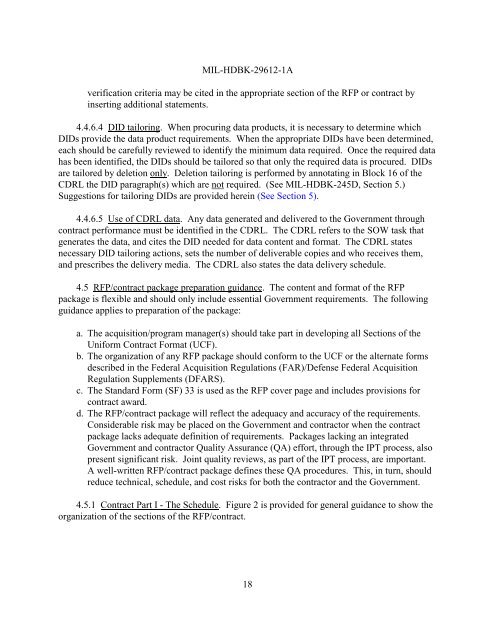department of defense handbook guidance for acquisition ... - NAVAIR
department of defense handbook guidance for acquisition ... - NAVAIR
department of defense handbook guidance for acquisition ... - NAVAIR
Create successful ePaper yourself
Turn your PDF publications into a flip-book with our unique Google optimized e-Paper software.
MIL-HDBK-29612-1Averification criteria may be cited in the appropriate section <strong>of</strong> the RFP or contract byinserting additional statements.4.4.6.4 DID tailoring. When procuring data products, it is necessary to determine whichDIDs provide the data product requirements. When the appropriate DIDs have been determined,each should be carefully reviewed to identify the minimum data required. Once the required datahas been identified, the DIDs should be tailored so that only the required data is procured. DIDsare tailored by deletion only. Deletion tailoring is per<strong>for</strong>med by annotating in Block 16 <strong>of</strong> theCDRL the DID paragraph(s) which are not required. (See MIL-HDBK-245D, Section 5.)Suggestions <strong>for</strong> tailoring DIDs are provided herein (See Section 5).4.4.6.5 Use <strong>of</strong> CDRL data. Any data generated and delivered to the Government throughcontract per<strong>for</strong>mance must be identified in the CDRL. The CDRL refers to the SOW task thatgenerates the data, and cites the DID needed <strong>for</strong> data content and <strong>for</strong>mat. The CDRL statesnecessary DID tailoring actions, sets the number <strong>of</strong> deliverable copies and who receives them,and prescribes the delivery media. The CDRL also states the data delivery schedule.4.5 RFP/contract package preparation <strong>guidance</strong>. The content and <strong>for</strong>mat <strong>of</strong> the RFPpackage is flexible and should only include essential Government requirements. The following<strong>guidance</strong> applies to preparation <strong>of</strong> the package:a. The <strong>acquisition</strong>/program manager(s) should take part in developing all Sections <strong>of</strong> theUni<strong>for</strong>m Contract Format (UCF).b. The organization <strong>of</strong> any RFP package should con<strong>for</strong>m to the UCF or the alternate <strong>for</strong>msdescribed in the Federal Acquisition Regulations (FAR)/Defense Federal AcquisitionRegulation Supplements (DFARS).c. The Standard Form (SF) 33 is used as the RFP cover page and includes provisions <strong>for</strong>contract award.d. The RFP/contract package will reflect the adequacy and accuracy <strong>of</strong> the requirements.Considerable risk may be placed on the Government and contractor when the contractpackage lacks adequate definition <strong>of</strong> requirements. Packages lacking an integratedGovernment and contractor Quality Assurance (QA) ef<strong>for</strong>t, through the IPT process, alsopresent significant risk. Joint quality reviews, as part <strong>of</strong> the IPT process, are important.A well-written RFP/contract package defines these QA procedures. This, in turn, shouldreduce technical, schedule, and cost risks <strong>for</strong> both the contractor and the Government.4.5.1 Contract Part I - The Schedule. Figure 2 is provided <strong>for</strong> general <strong>guidance</strong> to show theorganization <strong>of</strong> the sections <strong>of</strong> the RFP/contract.18

















